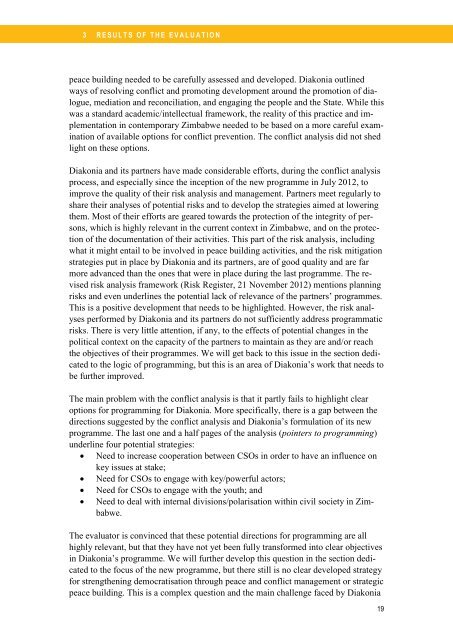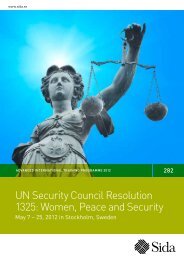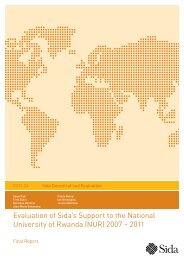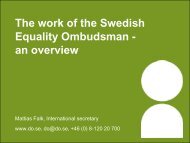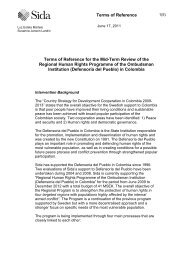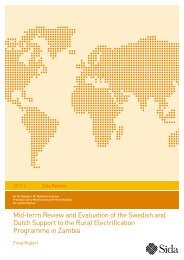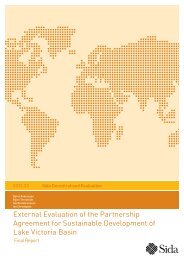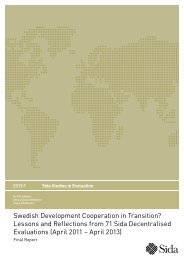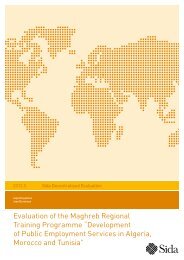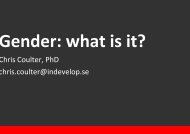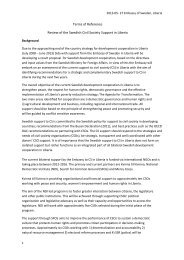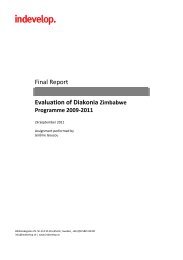Mid-term Review of the Diakonia Strategic Peace Building ... - Sida
Mid-term Review of the Diakonia Strategic Peace Building ... - Sida
Mid-term Review of the Diakonia Strategic Peace Building ... - Sida
You also want an ePaper? Increase the reach of your titles
YUMPU automatically turns print PDFs into web optimized ePapers that Google loves.
3 R E S U L T S O F T H E E V A L U A T I O N<br />
peace building needed to be carefully assessed and developed. <strong>Diakonia</strong> outlined<br />
ways <strong>of</strong> resolving conflict and promoting development around <strong>the</strong> promotion <strong>of</strong> dialogue,<br />
mediation and reconciliation, and engaging <strong>the</strong> people and <strong>the</strong> State. While this<br />
was a standard academic/intellectual framework, <strong>the</strong> reality <strong>of</strong> this practice and implementation<br />
in contemporary Zimbabwe needed to be based on a more careful examination<br />
<strong>of</strong> available options for conflict prevention. The conflict analysis did not shed<br />
light on <strong>the</strong>se options.<br />
<strong>Diakonia</strong> and its partners have made considerable efforts, during <strong>the</strong> conflict analysis<br />
process, and especially since <strong>the</strong> inception <strong>of</strong> <strong>the</strong> new programme in July 2012, to<br />
improve <strong>the</strong> quality <strong>of</strong> <strong>the</strong>ir risk analysis and management. Partners meet regularly to<br />
share <strong>the</strong>ir analyses <strong>of</strong> potential risks and to develop <strong>the</strong> strategies aimed at lowering<br />
<strong>the</strong>m. Most <strong>of</strong> <strong>the</strong>ir efforts are geared towards <strong>the</strong> protection <strong>of</strong> <strong>the</strong> integrity <strong>of</strong> persons,<br />
which is highly relevant in <strong>the</strong> current context in Zimbabwe, and on <strong>the</strong> protection<br />
<strong>of</strong> <strong>the</strong> documentation <strong>of</strong> <strong>the</strong>ir activities. This part <strong>of</strong> <strong>the</strong> risk analysis, including<br />
what it might entail to be involved in peace building activities, and <strong>the</strong> risk mitigation<br />
strategies put in place by <strong>Diakonia</strong> and its partners, are <strong>of</strong> good quality and are far<br />
more advanced than <strong>the</strong> ones that were in place during <strong>the</strong> last programme. The revised<br />
risk analysis framework (Risk Register, 21 November 2012) mentions planning<br />
risks and even underlines <strong>the</strong> potential lack <strong>of</strong> relevance <strong>of</strong> <strong>the</strong> partners’ programmes.<br />
This is a positive development that needs to be highlighted. However, <strong>the</strong> risk analyses<br />
performed by <strong>Diakonia</strong> and its partners do not sufficiently address programmatic<br />
risks. There is very little attention, if any, to <strong>the</strong> effects <strong>of</strong> potential changes in <strong>the</strong><br />
political context on <strong>the</strong> capacity <strong>of</strong> <strong>the</strong> partners to maintain as <strong>the</strong>y are and/or reach<br />
<strong>the</strong> objectives <strong>of</strong> <strong>the</strong>ir programmes. We will get back to this issue in <strong>the</strong> section dedicated<br />
to <strong>the</strong> logic <strong>of</strong> programming, but this is an area <strong>of</strong> <strong>Diakonia</strong>’s work that needs to<br />
be fur<strong>the</strong>r improved.<br />
The main problem with <strong>the</strong> conflict analysis is that it partly fails to highlight clear<br />
options for programming for <strong>Diakonia</strong>. More specifically, <strong>the</strong>re is a gap between <strong>the</strong><br />
directions suggested by <strong>the</strong> conflict analysis and <strong>Diakonia</strong>’s formulation <strong>of</strong> its new<br />
programme. The last one and a half pages <strong>of</strong> <strong>the</strong> analysis (pointers to programming)<br />
underline four potential strategies:<br />
Need to increase cooperation between CSOs in order to have an influence on<br />
key issues at stake;<br />
Need for CSOs to engage with key/powerful actors;<br />
<br />
<br />
Need for CSOs to engage with <strong>the</strong> youth; and<br />
Need to deal with internal divisions/polarisation within civil society in Zimbabwe.<br />
The evaluator is convinced that <strong>the</strong>se potential directions for programming are all<br />
highly relevant, but that <strong>the</strong>y have not yet been fully transformed into clear objectives<br />
in <strong>Diakonia</strong>’s programme. We will fur<strong>the</strong>r develop this question in <strong>the</strong> section dedicated<br />
to <strong>the</strong> focus <strong>of</strong> <strong>the</strong> new programme, but <strong>the</strong>re still is no clear developed strategy<br />
for streng<strong>the</strong>ning democratisation through peace and conflict management or strategic<br />
peace building. This is a complex question and <strong>the</strong> main challenge faced by <strong>Diakonia</strong><br />
19


